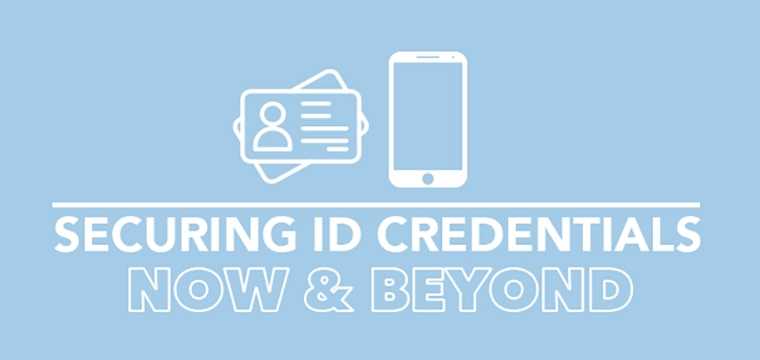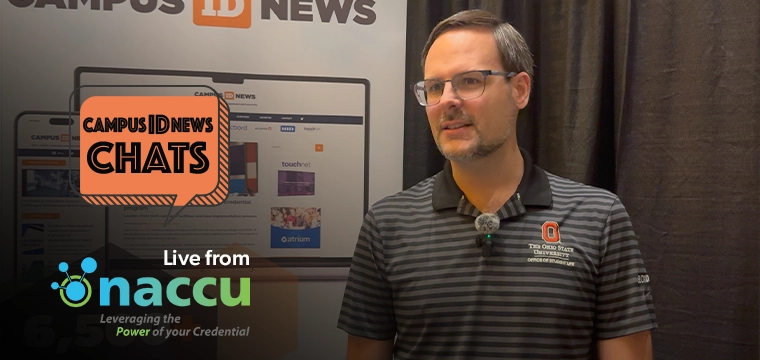ColorID's Danny Smith talks about layering identity between PeopleSoft or Banner and the systems that consume credentials
In this episode of CampusIDNews Chats, ColorID’s Danny Smith discusses the evolving landscape of identity management systems in higher education. He describes his concept of "critical identity infrastructure," which encompasses credentials, reader infrastructure, and the software used to manage identities.
This system typically resides within a one-card system, but Smith suggests a shift to a more open, agnostic platform. He says that by doing so, the identity infrastructure would allow for easier integration with new cloud-based solutions and greater flexibility for universities to adopt new technologies.
In this architecture, identity management is handled by an agnostic platform that pulls data from central authority sources like PeopleSoft or Banner.
He argues that traditional systems often create roadblocks by locking campuses into proprietary solutions, making it difficult to integrate new technologies without seeking permission from the service providers.
In this vision – what ColorID is calling the “Modern Campus” – identity management is handled by an agnostic platform that pulls data from central authority sources like Peoplesoft or Banner. It sits in between these sources and manages the credentials that power other applications and services on the campus. He says this allows institutions to be agile as they adopt new technologies, such as mobile credentials, biometrics, and cloud-based solutions.
Check out the full video by clicking on the image at the top of this page.
Transcript
Today on CampusIDNews Chats, we've got Danny Smith, co-founder, co-owner of Color ID, to talk about something that we kind of hit on about a month ago when we first spoke about their acquisition requirements.
And it's the idea, Danny, that you brought up about taking the identity management side of what we do with our campus credential systems and moving it from the transaction system and the access control system into a dedicated space.
So, critical needs identity infrastructure is something that you said multiple times when you talked. So, let's go over that a little bit.
Yeah, no, no, that's cool.
You know, critical identity infrastructure, that's how I define it.
And that's your credentials, your reader infrastructure, and then the software that you use to manage people, the credentials, and then also you have connections to downstream systems that the credential will authenticate with to access to those type services or solutions.
Typically you'll see the critical identity infrastructure is housed or resides within the one-part system. You will see some cases where that's in an access control system, but in higher education, primarily, it would be in the one-part system.
And so, you know, you can absolutely take the identity to the one-part system, and actually, we strongly recommend that as a future forward pathway to having a more agnostic approach, and a more enabled approach to be able to foster a lot of innovation and collaboration, and just a future forward approach that we're really excited about.
How does that specifically foster collaboration?
What you see as it exists right now is that not all of the one-part systems, but some of the one-part systems out there will use proprietary key sets that they deploy in the reader infrastructure and also in the credentials, and that makes the credentials and the critical identity infrastructure unique to those one-part systems.
And so, if you want to be able to integrate new solutions, cloud-based solutions that are coming in, justified ways, you need to have a data platform that's open to racist technology and innovation.
And the way it exists now is that you would have to go to the one-part system and say, hey, we found a new solution that we think would benefit our campus, it provides whatever value to the university, and then you have to ask for integration to a financial provider or the one-part provider.
And so, to me, if you're in that position, if you're having to ask permission to integrate solutions to a third-party provider, then that is a sign you've lost control of your infrastructure.
And so, it's not we're saying that what they're doing is malicious, it may be opportunistic, but what we're saying is that there's a better way to prove that it's going to help the university to be more modern in their approach to adopting new and modern technology.
So, we're taking it out of systems that it's been in for a long time in this new vision. Where does it go? What do you do with that function that's kind of crucial?
Yeah, no, it's an excellent question. You know, just, you have to figure this and kind of visualize the way that it works.
Is that you take the agnostic integration platform and it sits underneath and is connected to your authority source, which is what Peoplesoft or Banner, and it would pull in all these different integrations into the platform.
And then at that time, all the credentials were issued and managed from that down to all the downstream systems, including the one-part system.
So, what would happen is that you would take the identity infrastructure out of the one-part system, it would go into the agnostic identification and management platform, and then the one-part system would become a consumer of identity and not the gatekeeper or the manager of identity.
And all the other systems would be a consumer of identity, including your PAC systems, the third-party systems that are outside of the one-part scope of their service.
I've heard you say a number of times that we've had these discussions that you think higher education is at a technological inflection. So, what do you think about that?
Well, I think the way that things have worked the past 30 years is certainly a lot different than where we're going.
And you can see just, a good example would be going from on-prem to cloud, from the emerging technologies that you see, from credentials when you've gone from a match right to the prox, to the smart cards, to mobile credentials, but then you have other biometrics.
Ultra Wideband is something that you're hearing out there a lot that's gonna be introduced.
And there's other open standard credentials like Aliro, PKOC, and things that people may not even have heard about, but you have to be prepared to be able to quickly adapt.
And when you talk about identity, the inflection point is that the technology's changing.
We've got cloud-based solutions that are coming in. You gotta be able to be agile, to be able to quickly move from one to another if that's what the university wants to do.
Are you starting to see traction with this? Is the message resonating?
It's absolutely going fantastic. I just, and really it's validation for what we're doing. I mean, we saw a need, we heard from the customers. Over the years, this is not something that we've seen.
This has been a problem for years when there's been a lot of fractionalization in the campuses, a lot of slow data movement, just a lot of problems that this helped solve.
And right now we have over 40 universities that have already signed up and are on the modern campus utilizing the Card Exchange cloud solution.
And then in addition to that, we've probably done 50 presentations in the last three to four weeks. And we have folks that are already signing up. It's in the PO approval process, I guess you'd call it.
But yeah, I know this is a movement, man. We're really, really excited about it. It's a good thing. And it's nice to be on the right side of history, I think.
You know, if you want to learn more about the modern campus and our approach, just feel free to reach out. You can reach out to me directly at Danny dot Smith at colorid.com or at salesatcolorid dot com directly.
And then typically what we do is we schedule a introductory call, learn a little bit more about your campus, and then from there, we can schedule out a demo to take a deep dive into the solution itself.
All right, Danny, thanks a million. Great to talk to you as always.




